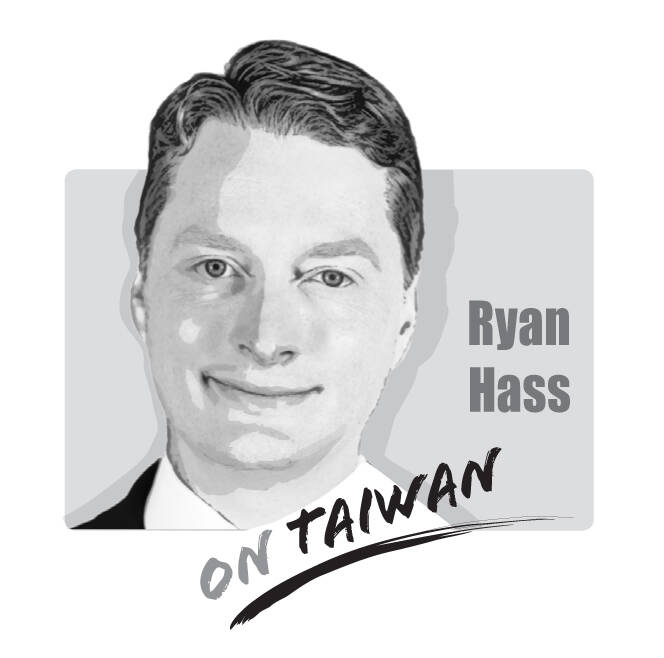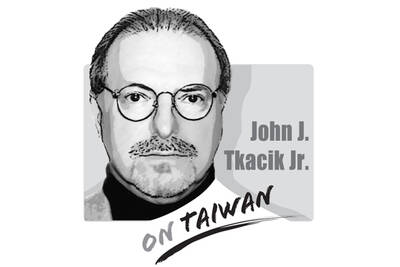World events are generating a lot of fodder these days for Chinese propagandists to construct arguments about the unraveling of American power on the world stage. In Beijing’s preferred narrative, the United States is the instigator of instability — arming Ukrainian forces to fight an unwinnable war and emboldening Israel to alter the distribution of power in the Middle East. The not-so-subtle message that China’s propagandists want to share with Taiwan voters is, “think carefully about who to depend upon for Taiwan’s security and prosperity.”
As with much of Beijing’s confected narratives, there is a grain of truth in observing that there is rising instability, particularly in Europe and the Middle East. The war in Ukraine is likely to grind on for the foreseeable future. Neither side has reached a mutually hurting stalemate that could create ripe conditions for negotiations. Both sides believe they stand to gain in the future: in Ukraine’s case, by retaking territory on the battlefield; and in Russia’s case, by waiting to see if Donald Trump reclaims the American presidency in 2024 and then adopts a more conciliatory posture toward Vladimir Putin.
In Israel/Gaza, there also is real risk of conflict spreading to the broader region. Israel’s leaders are determined to restore deterrence by exacting a punishing blow on Hamas and its leaders for their barbaric attacks on Israeli civilians on October 7. If Israel goes further by striking Iranian targets, or if Iran pushes its proxies to attack Israel and Israel responds against Iran, then violence could quickly spread.

In neither of these situations, however, is America stoking violence or encouraging escalation. Washington’s interests would be far better served by stability in Europe and the Middle East than by the inverse. In both cases, though, America chose to stand behind friends who were attacked.
As tragic as these events have been, they are not unique by historical standards. America has experience managing instability in various parts of the world even as it keeps a watchful eye on its principal competitors. Unlike previous instances, though, such as Iraq and Afghanistan, American forces are not tied down in combat as they were then.
More broadly, America’s relative position on the world stage is becoming stronger, not weaker. The United States posted blistering economic growth in the third quarter, expanding 4.9 percent year-on-year. The gap in size between the American and Chinese economies (as measured by nominal GDP) is widening now, not narrowing. The United States is attracting significant foreign direct investment, whereas China’s is experiencing capital outflows for the first time in years.
Up until recently, many technology experts such as Kai-Fu Lee (李開復) predicted that China would dominate the field of artificial intelligence (AI), given the country’s vast trove of data upon which to train its AI models. Instead, many of the world’s leading AI breakthroughs are occurring in the United States, not China. To be sure, China is leading the way in other technologies, such as electric vehicles and clean energy technologies. But in core areas such as AI and semiconductors, the United States still maintains an enviable position.
These trends speak to a broader truth about the state of the United States. Washington is mired in partisan gridlock. The United States Congress rarely misses an opportunity to showcase its failure to perform its most basic functions, such as confirming nominees for government appointments, passing a budget, and keeping government open. The public is deeply split along partisan lines. And yet, despite Washington’s dysfunction, the country has sustained its dynamism and energy. Many state and local-level leaders continue to govern with pragmatism and creativity, experimenting with ways to solve societal challenges and providing a model for national-level leaders to scale. America’s private sector continues to serve as an engine of innovation, developing technologies from the bottom up rather than following directions from the top down.
And even as President Biden’s attention often is pulled to wars in Ukraine and Israel/Gaza, he and his team have maintained a high tempo of engagement in the region that will matter most in the 21st century — the Indo-Pacific. The Biden administration has advanced an ambitious agenda for the Australia-United States-United Kingdom (AUKUS) partnership. Washington is deepening its trilateral partnership with Seoul and Tokyo. The Quadrilateral Group consisting of Australia-India-Japan-United States is delivering concrete solutions to some of the region’s most pressing challenges, including on counter-piracy and illegal fishing. America has strengthened its alliance with the Philippines and elevated its relationship with Vietnam. It also has enhanced its presence in the Pacific Islands.
America’s regional posture does have weaknesses. Washington’s lack of an ambitious trade agenda is a handicap. Its relationship with the Association of Southeast Asian Nations and some of its members also has underperformed.
And yet, for all its imperfections and the myriad global challenges it confronts, the United States still finds itself in a strong position. It is still where people from around the world turn when crises erupt. It is where many people from around the world still seek to emigrate. America still maintains the world’s largest economy and strongest military, and by a sizeable margin.
None of this is meant to suggest that Taiwan’s relationship with America is risk-free, especially when a US administration acts recklessly. But there is a risk for Taiwan in not aligning with a United States that is resilient and knows what it is doing externally. Fortunately, Taiwan voters have a choice in how best Taiwan should relate to major powers, and polling suggests that they are sensible and pragmatic on this question. On January 13, Taiwan voters will exercise that choice. On that date, the world will look on with interest. And I suspect some in China will watch with envy at the sight of people telling their leaders what matters most to them.
Ryan Hass is a senior fellow, the Chen-Fu and Cecilia Yen Koo Chair in Taiwan Studies, and the Director of the China Center at the Brookings Institution.

On May 7, 1971, Henry Kissinger planned his first, ultra-secret mission to China and pondered whether it would be better to meet his Chinese interlocutors “in Pakistan where the Pakistanis would tape the meeting — or in China where the Chinese would do the taping.” After a flicker of thought, he decided to have the Chinese do all the tape recording, translating and transcribing. Fortuitously, historians have several thousand pages of verbatim texts of Dr. Kissinger’s negotiations with his Chinese counterparts. Paradoxically, behind the scenes, Chinese stenographers prepared verbatim English language typescripts faster than they could translate and type them
More than 30 years ago when I immigrated to the US, applied for citizenship and took the 100-question civics test, the one part of the naturalization process that left the deepest impression on me was one question on the N-400 form, which asked: “Have you ever been a member of, involved in or in any way associated with any communist or totalitarian party anywhere in the world?” Answering “yes” could lead to the rejection of your application. Some people might try their luck and lie, but if exposed, the consequences could be much worse — a person could be fined,
On May 13, the Legislative Yuan passed an amendment to Article 6 of the Nuclear Reactor Facilities Regulation Act (核子反應器設施管制法) that would extend the life of nuclear reactors from 40 to 60 years, thereby providing a legal basis for the extension or reactivation of nuclear power plants. On May 20, Chinese Nationalist Party (KMT) and Taiwan People’s Party (TPP) legislators used their numerical advantage to pass the TPP caucus’ proposal for a public referendum that would determine whether the Ma-anshan Nuclear Power Plant should resume operations, provided it is deemed safe by the authorities. The Central Election Commission (CEC) has
When China passed its “Anti-Secession” Law in 2005, much of the democratic world saw it as yet another sign of Beijing’s authoritarianism, its contempt for international law and its aggressive posture toward Taiwan. Rightly so — on the surface. However, this move, often dismissed as a uniquely Chinese form of legal intimidation, echoes a legal and historical precedent rooted not in authoritarian tradition, but in US constitutional history. The Chinese “Anti-Secession” Law, a domestic statute threatening the use of force should Taiwan formally declare independence, is widely interpreted as an emblem of the Chinese Communist Party’s disregard for international norms. Critics